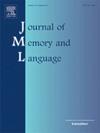说话者编码沉默结构:来自英语补语启动的证据
IF 3
1区 心理学
Q1 LINGUISTICS
引用次数: 0
摘要
说话者编码的抽象结构表征是否缺乏知觉运动内容,即音韵学?在六个基于回忆的生成实验中,我们检查了英语使用者是否使用结构启动在句子生成中编码空补语,即说话者重复使用他们最近遇到的结构的倾向。结果表明,无效补语可以在不同的结构类型中被启动,这种启动效应不能解释为显性补语缺失的启动效应。这些结果很难用语义、语用或音系术语来描述。此外,我们评估了两种神经网络语言模型(基于变形器和长短期记忆)再现人类启动模式的能力。尽管神经网络语言模型可以再现基本的启动效应,但与人类相比,神经网络语言模型对结构差异更敏感,而对抽象相似性更不敏感。这表明,仅靠分布线索可能不足以学习支配英语补语分布的概括。基于这些结果,我们认为说话人在生产过程中构建的结构表征超出了他们所听到和所说的。本文章由计算机程序翻译,如有差异,请以英文原文为准。
Speakers encode silent structures: Evidence from complementizer priming in English
Do speakers encode abstract structural representations devoid of perceptual-motor content, that is, phonology? In six recall-based production experiments, we examined whether English speakers encode the null complementizer in sentence production using structural priming, the tendency for speakers to reuse the structure they have recently encountered. The results show that the null complementizer can be primed across distinct construction types and that this priming effect cannot be explained as the priming of the absence of the overt complementizer. These results are difficult to capture in semantic, pragmatic, or phonological terms. Furthermore, we evaluated two varieties of neural network language models (based on transformers and long short term memory) for their capacity to reproduce human priming patterns. Although they could reproduce basic priming effects, neural network language models were simultaneously more sensitive to constructional differences and less sensitive to abstract similarities across constructions than humans. This suggests that distributional cues alone are likely not sufficient for learning the generalization governing the distribution of English complementizers. Based on these results, we argue that the structural representations speakers construct during production go beyond what they hear and say.
求助全文
通过发布文献求助,成功后即可免费获取论文全文。
去求助
来源期刊
CiteScore
8.70
自引率
14.00%
发文量
49
审稿时长
12.7 weeks
期刊介绍:
Articles in the Journal of Memory and Language contribute to the formulation of scientific issues and theories in the areas of memory, language comprehension and production, and cognitive processes. Special emphasis is given to research articles that provide new theoretical insights based on a carefully laid empirical foundation. The journal generally favors articles that provide multiple experiments. In addition, significant theoretical papers without new experimental findings may be published.
The Journal of Memory and Language is a valuable tool for cognitive scientists, including psychologists, linguists, and others interested in memory and learning, language, reading, and speech.
Research Areas include:
• Topics that illuminate aspects of memory or language processing
• Linguistics
• Neuropsychology.

 求助内容:
求助内容: 应助结果提醒方式:
应助结果提醒方式:


